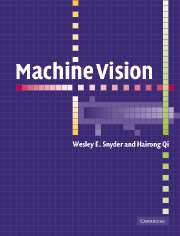Book contents
- Frontmatter
- Contents
- To the instructor
- Acknowledgements
- 1 Introduction
- 2 Review of mathematical principles
- 3 Writing programs to process images
- 4 Images: Formation and representation
- 5 Linear operators and kernels
- 6 Image relaxation: Restoration and feature extraction
- 7 Mathematical morphology
- 8 Segmentation
- 9 Shape
- 10 Consistent labeling
- 11 Parametric transforms
- 12 Graphs and graph-theoretic concepts
- 13 Image matching
- 14 Statistical pattern recognition
- 15 Clustering
- 16 Syntactic pattern recognition
- 17 Applications
- 18 Automatic target recognition
- Author index
- Index
16 - Syntactic pattern recognition
Published online by Cambridge University Press: 05 June 2012
- Frontmatter
- Contents
- To the instructor
- Acknowledgements
- 1 Introduction
- 2 Review of mathematical principles
- 3 Writing programs to process images
- 4 Images: Formation and representation
- 5 Linear operators and kernels
- 6 Image relaxation: Restoration and feature extraction
- 7 Mathematical morphology
- 8 Segmentation
- 9 Shape
- 10 Consistent labeling
- 11 Parametric transforms
- 12 Graphs and graph-theoretic concepts
- 13 Image matching
- 14 Statistical pattern recognition
- 15 Clustering
- 16 Syntactic pattern recognition
- 17 Applications
- 18 Automatic target recognition
- Author index
- Index
Summary
Ours is the age of substitution:
Instead of language, we have jargon;
Instead of principles, slogans;
and instead of genuine ideas, bright suggestions.
Eric BentleyIn this chapter, we discuss a completely different approach to pattern recognition, a methodology based on an analogy to language understanding. These methods have not often been used recently, primarily because they are very sensitive to noise and distortion. However, for certain applications, they may be appropriate, and the student is advised to learn enough about this topic to recognize potential applications.
Consider a boundary segment represented by a chain code. Each step in that chain code is a symbol, an integer between 0 and 7, so that the boundary segment is represented by a string of symbols: What makes syntactic methods work is the analogy between this string of symbols and the string of symbols which show up in the description of a formal language.
Terminology
To make more progress in this area, we need to define some terminology. The definitions are in reference to analysis of strings of symbols, such as occur in language analysis.
A terminal symbol: A word, like “horse,” “aardvark,” “professor,” “runs,” “grades.” Terminal symbols may also be line segments, parts of a picture, or other features. Generally, we denote terminal symbols using lower case. Most often, terminal symbols are denoted by a single symbol, like “a” or “0” but in the example of words from English, the terminal symbols are words, not letters.
- Type
- Chapter
- Information
- Machine Vision , pp. 369 - 381Publisher: Cambridge University PressPrint publication year: 2004



